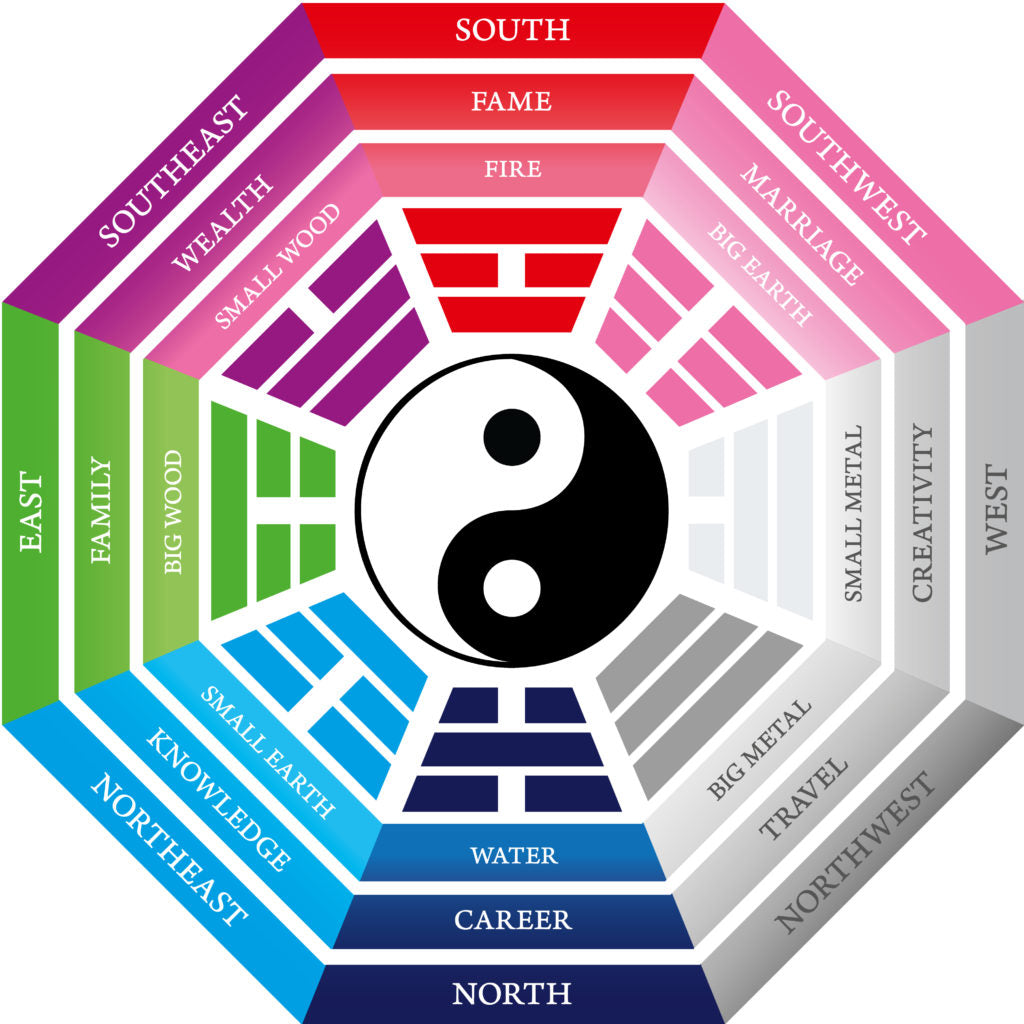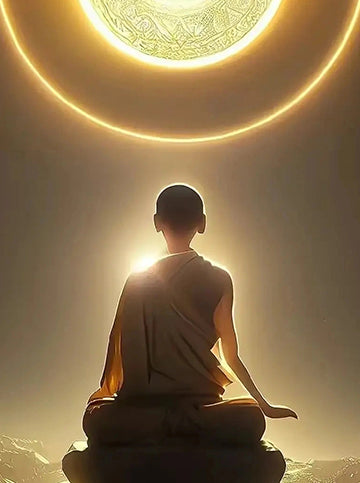The Bagua
The principal reference symbol in the practice of Feng Shui is the Bagua, or Pa Kua. This octagonal symbol corresponds to the four cardinal points of the compass and their four sub-directions. The four cardinal compass points are North (N), South(S), East(E)and West(W). Halfway between them are inter-cardinal points: Northwest(NW), Northeast(NE), Southwest(SW) and Southeast(SE). Each direction corresponds to one of the eight trigrams of Chinese metaphysics, derived from the I Ching. Trigrams are representative of our journey through life-each trigram has its own multiple sets of meanings, as well as supplementary symbols and connotations.
Each side of the Bagua also represents a life aspiration. The life aspiration areas are: mentors and networking, romance and marriage, family and ancestors, wealth and prosperity, career, recognition and fame, education and knowledge and, finally, children. These life aspirations are discussed more fully in later chapter.
In a nutshell, the basis of Feng Shui is about identifying your particular problem areas (or where you're currently "stuck") in relation to these life aspirations and how they have manifested physically in your home and living environment. Problem areas can manifest themselves as clutter, stagnant or unbalanced corners, neglected or unusually shaped rooms and inappropriately placed storage such as under a bed or over a work area. Identifying problem areas can be achieved by placing the Bagua over a plan of your home or room; enabling you to rectify and balance trouble spots and allow for more free-flowing energy in your life and home.
The symbols and directions of the Bagua are used as guides to create comfortable living and working environments. It is an ancient Chinese principle that applying positive Feng Shui to specific corners or sectors of the home encourages beneficial manifestations such as harmony, luck and fortune in your life. For example, you can activate the relationships corner of your home or bedroom if you are looking for a partner, or place symbols of prosperity in the wealth sector of your home office.
To apply the Bagua effectively, you will need a plan of your house drawn to scale -graph paper makes it easier and you will need to find the center and the front of your home. Then you will need a compass to align the Bagua with the relevant directions that each room faces. The front door is regarded as the "mouth" of the home, because it is where energy comes into your home. Paradoxically, the "mouth" doesn't have to be a dedicated front door, just the door you and your loved ones use regularly to enter the home. Regardless of where your front door is, it will always fall in one of these three areas, center(career), to the right of the center as you are facing it (travel and mentors) or to the left (knowledge and intuition).
By superimposing the Bagua over your plan of your entire home or just one room you can identify the problems associated with unusual, unbalanced shapes. Missing corners could indicate particular difficulties. If it's the career corner, it could mean difficulties at work; if it's the health corner it could be an ongoing illness. Going through your home room by room will help you understand where energy is stagnant or stale and where it needs to be cured by the application of Feng Shui.
The Lo Shu Magic Square
The good news is that the vast amount of information associated with the compass directions has been reduced to a shorthand form incorporated in the Magic Square. Many formulas based on the magic square are used to establish whether or not a place is auspicious. The Magic Square became the foundation of Taoist practice, and many of Taoism's rituals continue to be synchronized with its pattern.
According to history books of old China, the Magic Square dates back to 2005 BCE. The magic square is arranged so that when three numbers are added together, whether they are in a horizontal, vertical or diagonal line, the result is always 15, which also happens to be the number of days it takes for the new moon to become a full moon. The square has exerted a powerful influence on Chinese cultural symbolism, and the pattern of numbers has become inextricably linked with the trigrams of the Bagua. At the same time, the symbolism of the grid was extended to create connections between the numbers and the four celestial animals the dragon, the tiger, the turtle and the phoenix. These animals are symbolic of the landscape or cityscape which surrounds a home, building or city. The phoenix is the distant front view; the turtle is the protective hill (or building) at the back; the dragon is to the left and the tiger is to the right.
When a home is considered auspicious, all four symbolic animals surround it in a protective manner.
Correlations between the Magic Square and the Bagua become apparent when the grid is superimposed onto the Bagua using the compass directions as a guide-south is always equated with the number nine, and north is always represented by the number one. With the numbers in place, the Magic Square then unlocks further meanings within the Bagua.
Although tools such as the? Bagua, the Lo Shu or Magic Square assist with the practice of Feng Shui, everyday objects play their own role in its implementation. Bowls of brightly colored objects, lamps, artefacts and furniture all serve to direct or concentrate energy in the home.
This Bagua shows the various attributes which have been attached to the eight main directions by different Feng Shui systems. All the symbols belonging to one side of the Bagua are believed to be in harmony, complementary to each other. To create comfortable or auspicious living and working environments, the symbols and directions of the Bagua are used as guides by Feng Shui masters.
A Feng Shui tape, known as a Luben ruler, is just one of the tools you can use for measuring and dividing rooms in the home. Unlike the layman's measuring tape, used purely for the purposes of measuring, a Feng Shui tape also contains a repeated sequence of eight characters, representing auspicious and inauspicious categories. The eight characters symbolize: Ben (origin), Hai (harmful). Tie (robbery), Guan (official), Yi (righteousness), Li (separation). Bing (sickness) and Cai (wealth).
To apply the Bagua effectively, you will need a plan of your house drawn to scale -graph paper makes it easier -and you will need to find the center and the front of your home. Then you will need a compass to align the Bagua with the directions each room faces. By superimposing the Bagua over the plan of your entire home, or just one room, you can identify the problems associated with unusual, unbalanced shapes. Missing corners could indicate particular difficulties. If it's the relationships corner, it could indicate a growing rift in a marriage or partnership; if it's the fame/acknowledgment corner, perhaps your attempts at acknowledgment in a project are proving futile. In this house, the front entrance is in the knowledge area. Part of the fame / acknowledgment and relationship areas are missing and will need the application of Feng Shui remedies.
The "magic" in the Chinese Magic Square lies in the fact that every line of three numbers, whether chosen in a horizontal, vertical or diagonal line, always adds up to the number 15, which is also the number of days it takes for the new moon to become a full moon. This particular pattern of numbers is also linked with the trigrams and symbolism of the Bagua.
Scholars studying the origins of the Magic Square have speculated on the remarkable similarities between the grid's numbers and the ancient Hebrew sign for The planet Saturn. Dating back to 2005 BCE, the Magic Square became the foundation of Taoist magical practice. And today, many of Taoism's magic rituals continue to be synchronized in accordance with its "magical" pattern.

